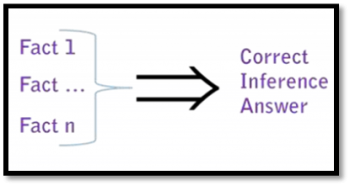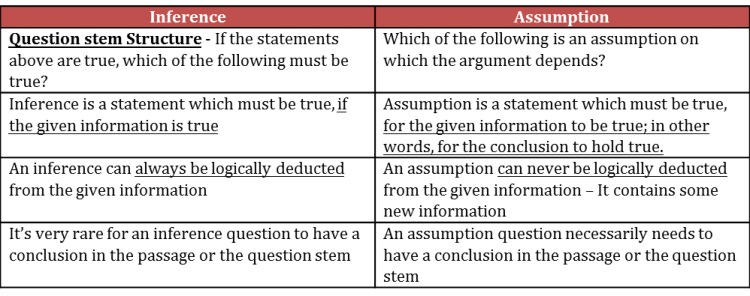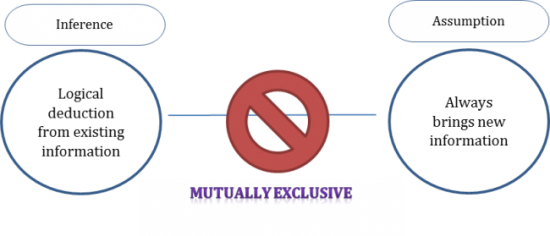Hi drebellion,
Quite a thorough analysis! I am impressed

drebellion wrote:
Hi Chiranjeev,
Thanks for the clarification and a "BIGER

" thank for pointing these questions.
Now first let me try these questions then I will discuss my takeaway.
Believe it or not, I have not looked the OAs for these questions. I wait for your response.
1)Sviatovin is a medieval Moringian text whose author and exact date of composition are unknown. However, the events in the life of Prince Sviatov that the text describes occurred in 1165, and in the diagram of Sviatov's family that accompanies the text his father, who died in 1167, is identified as still living. Thus Sviatovin must have been written between 1165 and 1167, assuming that.
P1)...events described happened in 1165
p2)...S's father who died in 1167 was alive in the text.
=>Concl: Sviatovin must have been written between 1165 and 1167
My pre-thinking assumption (as I wrote on paper):
-Sviatovin is not a work of fiction...the is real depiction of events described.Choice C is even more narrow and well defined "to the point" Assumption.(A) the life of Prince Sviatov is not the subject of any other medieval Moringian texts
Even if it is the case how that will say help me find out when S was written ? OFS(B) the author of Sviatovin intended it to provide as accurate a report about Prince Sviatov's exploits as possible
1)What is as accurate a report as possible mean here ? 2) How author's accuracy is going to help me find the time whaen the text was written?(C) the diagram accurately represents the composition of Sviatov's family at the time Sviatovin was written
A narrowed down/in the line (compared to my pre-thought assumption) 'to the point' assumption(D) Sviatovin is the earliest Moringian text whose composition can be dated to within a few years
1)OFS 2) "within a few year" what does that mean? 2, 20, or 50 ???(E) Sviatovin was not written by Sviatov's father himself
Anyone can write the text, why only S's father?--------------------------
2) Although parapsychology is often considered a pseudoscience, it is in fact a genuine scientific enterprise, for it uses scientific methods such as controlled experiments and statistical tests of clearly stated hypotheses to examine the questions it raises.
The conclusion above is properly drawn if which of the following is assumed?
P1)parapsychology is often considered a pseudoscience
P2)for it uses scientific methods such as controlled experiments and statistical tests of clearly stated hypotheses to examine the questions it raises
=>Concl: parapsychology is in fact a genuine scientific enterprise
Pre-thought assumption (as I wrote on paper):
A1):Any field of study that uses scientific methods to examine the questions it raises CAN be a genuine scientific enterprise
(A) If a field of study can conclusively answer the questions it raises, then it is a genuine science.
OFS(B) Since parapsychology uses scientific methods, it will produce credible results.
RESULTS??? iSWAT(C) Any enterprise that does not use controlled experiments and statistical tests is not genuine science.
iSWAT, talks about examples gives in the arguments but not relevant (D) Any field of study that employs scientific methods is a genuine scientific enterprise.
A broader assumption than my pre-thought assumption(E) Since parapsychology raises clearly statable questions, they can be tested in controlled experiments.
OFS--------------------------
3)In recent years many cabinetmakers have been winning acclaim as artists. But since furniture must be useful, cabinetmakers must exercise their craft with an eye to the practical utility of their product. For this reason, cabinetmaking is not art.
Which of the following is an assumption that supports drawing the conclusion above from the reason given for that conclusion?
P1)...cabinetmakers have been winning acclaim as artists
P2)But since furniture must be useful,
P3) cabinetmakers must exercise their craft with an eye to the practical utility of their product (they pay attention to practical utility of their product = they make them useful)
=> Concl: (For this reason; P1+2+3) cabinetmaking is not art
Pre-thought assumption (as I wrote on paper):
A1)Things which are made for practical utility cannot contain art
A2) Any useful article cannot be a piece of art(A) Some furniture is made to be placed in museums, where it will not be used by anyone.
OFS(B) Some cabinetmakers are more concerned than others with the practical utility of the products they produce.
SO WHAT? OFS how it is related with whether Cabinetmakers are artist or not (C) Cabinetmakers should be more concerned with the practical utility of their products than they currently are.
SO WHAT? how it is related with whether Cabinetmakers are artist or not (D) An object is not an art object if its maker pays attention to the object’s practical utility.
Almost paraphrase of my pre-thought assumption(E) Artists are not concerned with the monetary value of their products.
OFS--------------------------
Almost everything is right on point till here. I'll make my comments below.
drebellion wrote:
Analysis, Conclusion and Takeaway (for me):
1)Rahul is more informed...
a1) Rahul must have read that particular email - the ABSOLUTE minimum, the most narrowed down assumption
a2) Rahul has read every mail that he received - A wider assumption which contain the above assumption
2)Sviatovin is a medieval Moringian....
I came up with just some vague idea... no good assumption phrase.
the ABSOLUTE minimum, the most narrowed down assumption will be:
a1)the diagram accurately represents the composition of Sviatov's
father[/u] at the time Sviatovin was written
A wider assumption would be:
a2)the diagram accurately represents the composition of Sviatov's [u]family at the time Sviatovin was written
* a diagram can have only one time frame, so if his fathers description was right then tah twill apply to the whole diagram and so to his family, i.e. a1) implies a2) and vice versa.
Actually, a2 implies a1, not the othe way round. a1 is the absolute minimum required but a2 is what we are given in the passage. If a2 holds, then a1 also holds.
drebellion wrote:
3)Although parapsychology is often considered a pseudoscience
the ABSOLUTE minimum, the most narrowed down assumption will be;
a1) Any field of study that uses scientific methods to examine the questions it raises CAN be a genuine scientific enterprise -
I would say the absolute minimum is:
If parapsychology uses scientific methods, then it is a genuine scientific enterprise. (This is the absolute minimum. We are at the minimum concerned about parapsychology, not all fields of study)
drebellion wrote:
A wider assumption (containing a1) would be:
a2) Any field of study that employs scientific methods is a genuine scientific enterprise.
- a1 is contained in a2
Right

drebellion wrote:
4)In recent years many cabinetmakers have be
here a1 and a2 are essentially same
Here, the absolute minimum is:
If cabinetmaking is built with an aim pf practical utility, then it is not an art.
Broader assumption is option D.
drebellion wrote:
Conclusion and Takeaway (for me):
1) Sometime (may be many times) a broader assumption which contain the ABSOLUTE narrowed down assumption are the right assumption
Well, we are playing with fire here. Seriously! Because if someone reads it and takes it literally, then the whole basis of "Negation Test" may vanish. We need to understand what we are talking about here.
Even though we have seen that the correct option statements may be broader than then absolute minimum assumptions but we should also understand that the context of the argument demanded the broadness inherent in the option statements. For example: In Sviatovin question, we are talking about a family diagram; even though we are only concerned about the accuracy of the depiction of the father but since the diagram is about the family, we should talk about the accuracy of the diagram as a whole and not about pieces in the diagram. Therefore, when the option statement talks about the accurate depiction of Sviatovin's family, it is not really broader than required; common sense wise, this is what we want.
Well, if we go by formal logic, then we can say that the given option statement is broader than required and hence, is not a must be true statement. But, by common sense, which is actually tested in GMAT, we should understand that the given option statement that talks about the diagram as a whole and not about pieces, is actually correct and a must be true statement.
drebellion wrote:
2) The pre-thought assumption might be a wider/broader assumption, the choice may give a narrowed down assumption.
That is going to happen a lot of time!
Well, my comments especially on your takeaway require very subtle understanding and you may not be able to appreciate all that is written. But, you need not worry.
What you need to remember is that if, in a question, you have two option statements, one a broader assumption and one a narrow one, then select the narrow one because in that case, you are being given a choice to be as narrow as possible. Take a stab at the following
OG question:
"A proposed change to federal income tax laws would eliminate deductions from taxable income for donations a taxpayer has made to charitable and educational institutions. If this change were adopted, wealthy individuals would no longer be permitted such deductions. Therefore, many charitable and institutions would have to reduce services, and some would have to close their doors.
The argument above assumes which of the following?
(A) Without incentives offered by federal income tax laws, at least some wealthy individuals would not donate as much money to charitable and educational institutions as they otherwise would have.
(B) Money contributed by individuals who make their donations because of provisions in the federal tax laws provides the only source of funding for many charitable and educational institutions.
(C) The primary reason for not adopting the proposed change in the federal income tax laws cited above is to protect wealthy individuals from having to pay higher taxes.
(D) Wealthy individuals who donate money to charitable and educational institutions are the only individuals who donate money to such institutions.
(E) Income tax laws should be changed to make donations to charitable and educational institutions the only permissible deductions from taxable income."
Thanks,
Chiranjeev








